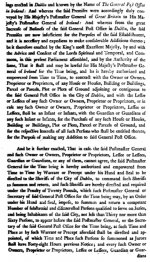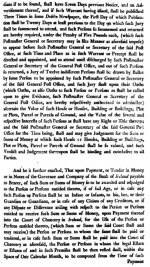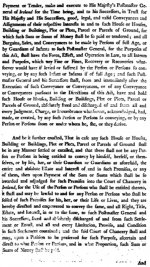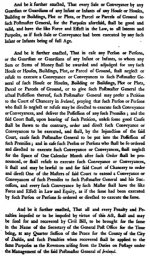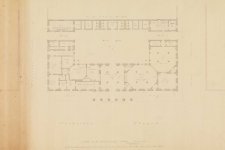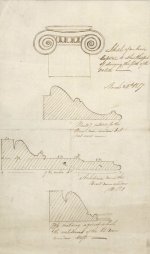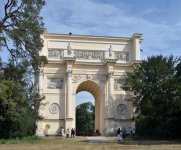I wasn't planning on writing this article, but figured why not. The article will cover a bit more than just the Dublin Post Office building, for the issue we're facing is somewhat more serious. Looks like the so-called "ancient Rome" is involved in this story. Several SH Blog articles could serve as a semi-mandatory prerequisite to understand what I'm about to present to you.
- The PTB History Fabrication Tools
- SPQR this & SPQx that. Empires were everywhere.
- Dating: Bricks Tell the Story
- The Dark Secret of the Vatican Pagan Gods
- When Jesus abandoned America, or why TPTB prefer Pagan Gods
- Questionable Antiquity of the "Ancient" Statues
- Fake Antiquity: the bust of Julius Caesar. Why?
Buildings do not come from nowhere, but to understand who could build a specific structure during a specific time frame, we would need to understand what system of governance was in place in Dublin between 1814 and 1818. This is when our Post Office was allegedly built.
I will present for your judgement a theory, where this Dublin Post Office (as well as many other buildings in the world) was built by:
- The Roman Corporation
- aka Roman League (it was either very similar to the Hanseatic League, or we are talking about one and the same League, split in many pieces by the PTB presented version of history)
- The Hanseatic League was a commercial and defensive confederation of merchant guilds and market towns in Northwestern and Central Europe.
- Growing from a few North German towns in the late 1100s, the league came to dominate Baltic maritime trade for three centuries along the coasts of Northern Europe.
- Hansa territories stretched from the Baltic to the North Sea and inland during the Late Middle Ages, and diminished slowly after 1450.
- aka Ancient Rome
- aka Holy Roman Empire
- There was nothing ancient about this "ancient Rome" because we are talking about 1400-1840 time frames here.
Dublin Corporation
1661-1840
Dublin Corporation known by generations of Dubliners simply as The Corpo, is the former name given to the city government and its administrative organization in Dublin between 1661 and 1 January 2002.1661-1840
- Dublin Corporation first came into being under the Anglo-Normans in Dublin in the late 13th century.
- For centuries it was a two-chamber body, made up of an upper house of 24 aldermen, who elected a mayor from their number, and a lower house, known as the "sheriffs and commons", consisting the 48 sheriff's peers and 96 representatives of guilds.
- The modern Dublin Corporation was restructured by late 19th-century and 20th-century legislation, particularly, the Municipal Corporations Act 1840.
- We are not interested in the period after 1840. Our Post Office was built prior to 1840. Additionally, I believe that the political setup became drastically different after 1840.
- Original text: Obedientia Civium Urbis Felicitas
- Translation from Latin: The Obedience of the citizens produces a happy city.
The Statue of George II
- He was also a prince-elector of the Holy Roman Empire from 11 June 1727 (O.S.) until his death in 1760.
This "freely translated" was translated way too freely for my liking, because from what we understand, the well known S.P.Q.R is an emblematic abbreviated phrase referring to the government of the ancient Roman Republic. Therefore, S.P.Q.D. can mean only one thing:
- Senātus Populusque Dublinis (or Dublinium)
- I am not positive on the proper Latin spelling of Dublin.
- This source suggests that it could be one of the above two versions.
- The Senate and People of Dublin
- To understand the significance of SPQD you, absolutely, have to read this article: SPQR this & SPQx that. Empires were everywhere.
Roman Corporation aka Roman League
IMHO, in this case, "league" and "corporation" could mean the exact same thing. I did not think it was gonna be so easy to find a direct reference to both the Roman Corporation and the Roman League.In the below example, we have this "Colony of Heraclea in the Great Magistrate of Naples".
This is our Herculaneum, covered in the below articles:
And while the above is clearly a smoking gun confirming that the PTB Pompeii and Herculaneum narrative is full of holes through which we can see the light of truth, it's the below statement we are interested in (for the purposes of this article).
- Not conquered, but received into...
- It's probably because we have this coin, right?
KD: Anyways, these were just a few examples. If you need more, please help yourself by visiting the below links.
Legion vs Leagion
Could it be that our understanding of the word "legion" is totally off due to certain adjustments made by the PTB. I'm referring to "leagion" being possibly related to the word "league". As it stands we have the following etymological explanation for "legion".- Attested (in Middle English, as legioun) around 1200, from Old French legion, from Latin legiō, legionem, from legō (“to gather, collect”); akin to legend, lecture.
One of the greatest misrepresentations introduced by the PTB was the so-called Renaissance. That is if they did not outright invent it. One way, or another, it allowed to indoctrinate many of the so-called "ancient Roman" things into the contemporary world. And boy, did they convolute this "Renaissance" period.
As you can see, our Georgius Augustus was the princeps of Wales, then, after a comma we see "Electoratus Runswick-Lüneburg Haeres" and bla-bla-bla. Even if we consider, that "Haeres aka Heir" does mean a successor, there is still a humongous difference between prince and princeps.
- Meanwhile, the narrative compliant etymological explanation wants us to think that at a specific moment in time (1727-1760 in this case), these two words meant the exact same thing.
A prince is a male ruler (ranked below a king, grand prince, and grand duke) or a male member of a monarch's or former monarch's family. Prince is also a title of nobility (often highest), often hereditary, in some European states.
Princeps is a Latin word meaning "first in time or order; the first, foremost, chief, the most eminent, distinguished, or noble; the first man, first person".
- As a title, "princeps" originated in the Roman Republic wherein the leading member of the Senate was designated princeps senatus.
- It is primarily associated with the Roman emperors as an unofficial title first adopted by Augustus (reigned 27 BCE – 14 CE) in 23 BCE.
- Its use in this context continued until the reign of Diocletian (r. 284 – 305 CE) at the end of the third century.
- He preferred the title of dominus, meaning "lord" or "master".
- Princeps
- The prince-electors, or electors for short, were the members of the electoral college that elected the emperor of the Holy Roman Empire.
What about the "Augustus" portion of Georgius Augustus?
- Augustus -The title given to the ruling emperor as being the senior ruler of the empire.
- Abbreviations like AVG could have multiple G's (AVGG) which would indicate a joined rulership of the empire.
- Augustus "majestic", "great" or "venerable") was an ancient Roman title given as both name and title to Gaius Octavius (often referred to simply as Augustus), Rome's first Emperor.
- On his death, it became an official title of his successor, and was so used by Roman emperors thereafter.
And, I wanted to use this image one more time, for we do have two titles to cover.
- The Praetor Urbanus was specially named Praetor, and he was the first in rank. His duties confined him to Rome, as is implied by the name, and he could only leave the city for up to ten days at a time. It was part of his duty to superintend the Ludi Apollinares.
- He was also the chief magistrate for the administration of justice, and to the Edicta of the successive praetors the Roman Law owes in a great degree its development and improvement.
- Vice Comitibus took me a few minutes to figure out. I will just live it at that.
Of course, the PTB want us to think that role playing was just a popular thing at the time.
Sounds like we do not even know whether Dublin is the proper name for this city. Of course we are positive that we do know. After all, what else is new?
- Please help yourself to see what the PTB has to say about the history of Dublin. How many times did they mention Ascheled?
- Weird, they were finally able to use an actual "1" instead of "I" in 1786.
- The verb "shanghai" joined the lexicon with "crimping" and "sailor thieves" in the 1850s, possibly because Shanghai was a common destination of the ships with abducted crews.
- Æsir is thus the plural of áss, ǫ́ss "god"
- The Æsir are the gods of the principal pantheon in Norse religion. They include Odin, Frigg, Höðr, Thor, Baldr and Týr.
Older Maps
I am not sure where I got the below map of Ireland aka Hibernia from. As far as I remember it was dated with either 17th or 16th century.The below image was allegedly produced in 1607.
Maps of this nature are multiple. The below map is taken from this 1835 book. This book was scanned by Google upside down.
Fully Developed Government
It looks like we do not want to admit how developed, and sophisticated governments of that time were. After reading the below document (published in 1808) I do not think their system was any different from our today's bureaucratic setup. Or may be it's the other way around, and we are not too different from them.- This is Volume 15, by the way.
But what's interesting, in 1820's, with no recognizable research and development, we have this tremendously downplayed system of motorized public transportation. It came from nowhere, and left in the same direction. The PTB narrative provided a few BS excuses, and that was it. Wanna guess how many years we had to wait for this technology to resurface?
I'm a firm believer that palaces do not get built without everything else being on par. IMHO, their real infrastructure was omitted from our narrative.
The General Post Office of Dublin
Here is a short synopsis based on the traditional narrative.
- The foundation-stone of the building, which was designed by Francis Johnston, was laid by the Lord Lieutenant of Ireland, Charles Whitworth, 1st Earl Whitworth, on 12 August 1814, attended by the Post-Masters-General, Charles O'Neill, 1st Earl O'Neill and Laurence Parsons, 2nd Earl of Rosse.
- The structure was completed in the short space of approximately three years at a cost (depending on sources) of between £50,000 and £80,000.
- The front, which extends 67.1 metres (220 ft), has an Ionic portico (24.4 metres (80 ft) wide), of six fluted Ionic columns, 137.16 centimetres (54 inches) in diameter.
- The frieze of the entablature is highly enriched, and in the tympanum of the pediment were the royal arms until removed following restoration in the 1920s.
- On the acroteria of the pediment are three statues by John Smyth. When facing the building:
- With the exception of the portico, which is of Portland stone, the main building is of mountain granite.
- The elevation has three stories, of which the lower or basement is rusticated.
- The General Post Office in Ireland was first located in High Street in Dublin moving to Fishamble Street in 1689, to Sycamore Alley in 1709 and then in 1755 to Bardin's Chocolate House on the site where the Commercial Buildings used to be (now the Central Bank building) off Dame Street.
- It was afterwards removed to a larger house opposite the Bank of Ireland building on College Green.
- On 6 January 1818, the new post-office in Sackville Street (now O'Connell Street) was opened for business.
- General Post Office, Dublin
The Three Statues
In my opinion, this is where the entire history of this building starts and ends, for there is not a single reason for these statues to be on this building.
- Mercury on the left, with his Caduceus and purse;
- Fidelity on the right, with a hound at her feet and a key held in her right hand;
- due to these features it is argued that the statue is in fact of Hecate
- Hibernia in the centre, resting on her spear and holding a harp.
Irish Immigration to America
Before we talk about the statues, let's see who (and why) was immigrating to America from Ireland around 1810-1815, for this is when this building was allegedly built.- In the 18th century, emigration from Ireland to the Thirteen Colonies shifted from being primarily Catholic to being primarily Protestant, and with the exception of the 1790s it would remain so until the mid-to-late 1830s, with Presbyterians constituting the absolute majority until 1835.
- Religious freedoms and economic hardship?
Christianity in Ireland
Conclusion: I think it is fair to say that ancient Roman/Greek pagan religions were not predominant ones in Ireland when this Post Office was being built. It is also fair to say that the narrative fails to mention that these ancient religions even existed in Ireland during this particular time frame.
Back to the Statues
Let's take three countries and three statues, and see what these three countries could have in common as far as statues go. Well, may be we should call statues for what they are - pagan Goddesses. These countries and Goddesses are:We can obviously argue about semantics, but there is very little left for imagination here.
Below we have Hibernia and Britannia hanging out together. Where is Jesus?
But it's not really important that Hibernia, imo, was supposed to represent the goddess of war Athena aka Minerva, for we have two more statues mounted on top of the Post Office, presumably, designed and built by Christians.
- Mercury is a major god in Roman religion and mythology, being one of the 12 Dii Consentes within the ancient Roman pantheon. He is the god of financial gain, commerce, eloquence, messages, communication, travelers, boundaries, luck, trickery and thieves; he also serves as the guide of souls to the underworld.
- aka Hermes
Fidelity - could be Fides.
- Fides was the goddess of trust and good faith in Roman paganism. She was one of the original virtues to be considered an actual religious divinity. Fides is everything that is required for "honour and credibility, from fidelity in marriage, to contractual arrangements, and the obligation soldiers owed to Rome."
- Can't find a good quality image, but chances are, that key does not belong there either.
- Hecate is a goddess in ancient Greek religion and mythology, most often shown holding a pair of torches or a key and in later periods depicted in triple form. She is variously associated with crossroads, entrance-ways, night, light, magic, witchcraft, knowledge of herbs and poisonous plants, ghosts, necromancy, and sorcery.
Or like this...
To be honest, I did not find an image of Hecate with a key. Wiki description says she had one. But who I did find with a key was
- Cybele - In Rome, Cybele became known as Magna Mater.
Of course, Cybele, being our good old Magna Mater can also look like this.
- This takes us to the Ancient Genetics Factory: The Temple of Artemis
- Why did they mess with the statues?
- Was their Dublin church and church members like... yup, go ahead, and worship pagan Gods in our Christian city of Dublin?
- Or, were they sold the exact same BS we have to consume, where these are just symbols of nothingness?
- When Jesus abandoned America, or why TPTB prefer Pagan Gods
- The Dark Secret of the Vatican Pagan Gods
- The source of the below image
- The Crescent Moon is addressed below
The Creators
- Meanwhile, some Irishmen were seeking religious freedoms on the other side of the Atlantic ocean.
- Washington - Mozart - Napoleon - Wellesley
With new generations coming up, we can rest assured that the knowledge will not get lost.
O'Connell Street
They sure did like renaming things back in the day. On 6 January 1818, the new post-office in Sackville Street (now O'Connell Street) was opened for business.- O'Connell Street is a street in the centre of Dublin, running north from the River Liffey.
- During the 17th century, it was a narrow street known as Drogheda Street, named after Henry Moore, Earl of Drogheda.
- It was widened in the late 18th century by the Wide Streets Commission and renamed Sackville Street after Lionel Sackville, 1st Duke of Dorset.
- In 1924, it was renamed in honour of Daniel O'Connell, a nationalist leader of the early 19th century, whose statue stands at the lower end of the street, facing O'Connell Bridge.
Drogheda History
As we can see, the Drogheda street was named after Henry Moore, the 1st Earl of Drogheda. I find it interesting that this esteemed Irish gentleman with the last name of Moore had a coat of arms looking like this.- Escutcheon: Azure on a chief indented Or three mullets pierced Gules.
- Crest: Out of a ducal coronet a Moor’s head Proper wreathed about the temples Argent and Azure.
- Supporters: Two greyhounds Argent.
- Created: 1661
- First Holder: Henry Moore
- Earldom of Drogheda
- In other words, we do not appear to know what he looked like.
By the way, here is the PTB way to cover BS with BS:
- BS #1: Despite the common misconception that Moor's heads are representations of unknown Muslims defeated in battle,
- BS #2: evidence suggests most known Moor's heads are representations of specific Africans in honor of their contributions to Catholics in Europe.
- Source
The Drogheda Town

As you can see, Drogheda is also a town located 25-30 miles north of Dublin. I did not look into its hidden history yet, but on the surface we have this nice crescent moon.
Or these two symbols:
- On the left: Painting of Inca Manco Capac. Created between 1750 - 1800
- Manco Cápac - Wikipedia, died c.1230AD
- On the right: Roman fence from Emperor Constantine the Great's villa, Mediana, Serbia, 272AD - 337AD
And if the star was supposed to symbolize our Sun, then who knows where the limits of lies are?
Back to the Post Office
As we know, the Post Office was allegedly built between 1814 and 1818. The street where the Post Office stands today was renamed from Drogheda street to Sackville street some time after 1750-60, and in 1924 from Sackville to O'Connell street. This is what the area supposedly looked like in 1750-60's.The following description of the Sackville street was provided in a publication issued in 1790.
In 1841 we will have the same street looking something like this.
In 1916 (and just prior to being damaged), our Sackville street was supposed to have the following appearance.
- As you can see, our Post Office is not that far from the River Liffey.
- It's about 650-700 feet, per Google Maps.
- This should help you out to imagine the general location of the Post Office on the above images.
I just mentioned 1916 damages to the Post Office building. The reason for the damages was the Easter Uprising. Sounds like "with much greater numbers and heavier weapons, the British Army suppressed the Rising."
- Members of the Irish Volunteers, led by schoolmaster and Irish language activist Patrick Pearse, joined by the smaller Irish Citizen Army of James Connolly and 200 women of Cumann na mBan, seized strategically important buildings in Dublin and proclaimed the Irish Republic.
- The main rebel positions were gradually surrounded and bombarded with artillery.
These two pictures allow for a lot of questions.
A detailed inspection of the above images suggests that our "shell of the G.P.O." could be a brick building covered in granite veneer blocks.
And whatever you feel like calling this portion of the contraption, it was clearly made of brick.
Per the narrative:
- With the exception of the portico, which is of Portland stone, the main building is of mountain granite.
- Did the PTB forget to mention mountains of bricks used?
Ruins of the interior of the General Post Office following the 1916 Rising.
- Concrete pillars and metal reinforcement beams?
Today, the courtyard area walls of the Dublin Post Office are clearly made of brick, whatever that means.
Construction Documentation
Meanwhile, this here is all we appear to have available on the internet.
- The GPO - Two Hundred Years - Irish Architectural Archive
- The General Post Office, O'Connell Street, Dublin
As it stands, this is laughable. These are copies of the original 1930 blueprints for the main building of the Lew Wallace School. Really, who needed something like that in 1814?
When was the GPO of Dublin built?
- There are several linked maps on this page. May be you can figure out when this building first pops up on the maps.
It sure looks like in 1756 the future Dublin General Post Office building was already there.
KD: The PTB had between 400 and 600 years to iron their historical narrative out. Some of the narrative compliant things of 1600's were no longer narrative compliant in 1700s, hence you won't see them in the books produced in 1700's. Same goes for 1800's, 1900's and 2000's. Today's version of history is reasonably polished, and allows for a much easier and rather smooth delivery of the narrative. Governments maintain a pretty tight grip on their curriculums.
- IMHO, the moment our contemporary historians accepted those three pagan statues, their credibility has ended.
- Chances are, between 1814 and 1818, the older brick building received a granite veneer face lift.
- May be this is when those columns and other Roman architectural attributes were added.
It appears that they indeed purchased a pre-existing building in order to "enlarge" the General Post Office in Dublin. At least, this is how I understand the below 1814 information.
The definition of premises:
- In real estate, land and the improvements on it, a building, store, shop, apartment, or other designated structure
- Premises are land and buildings together considered as a property
- A house or building, together with its land and outbuildings, occupied by a business or considered in an official context
- That means that the Dublin General Post Office building is at least 58 years older than we are told.


